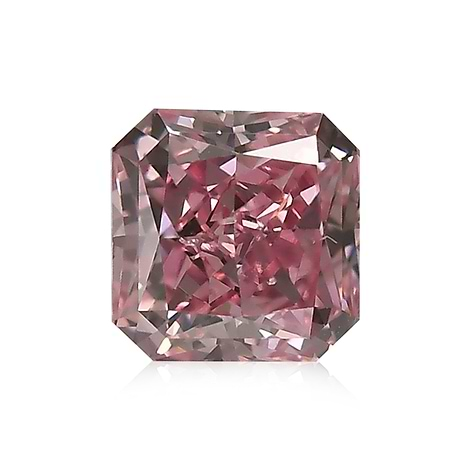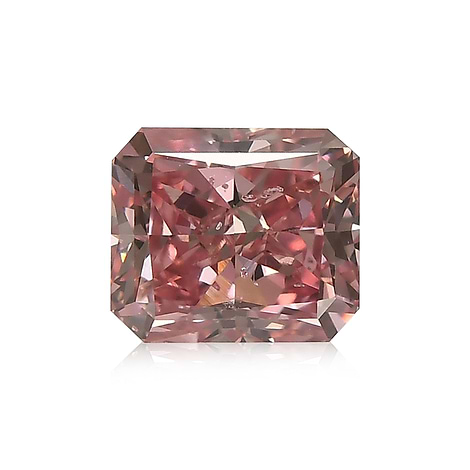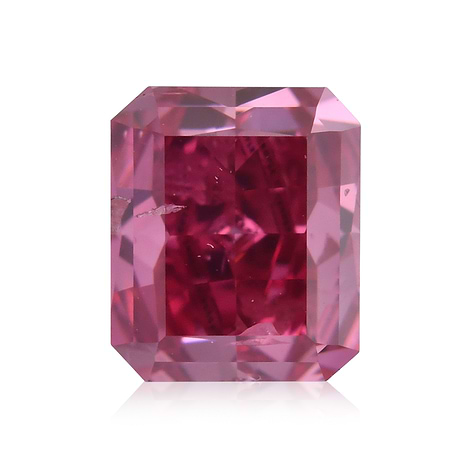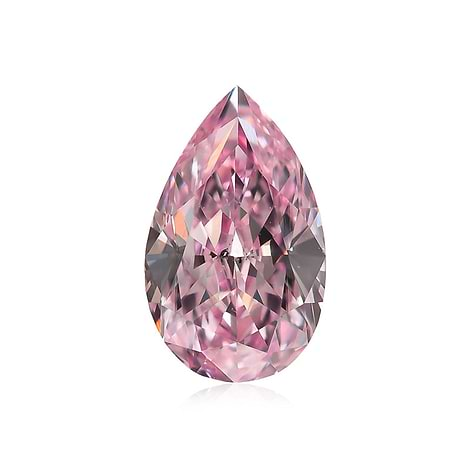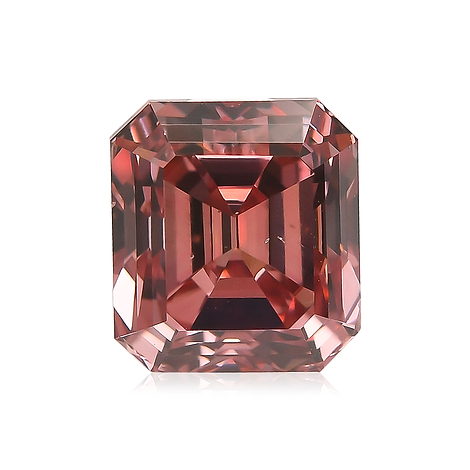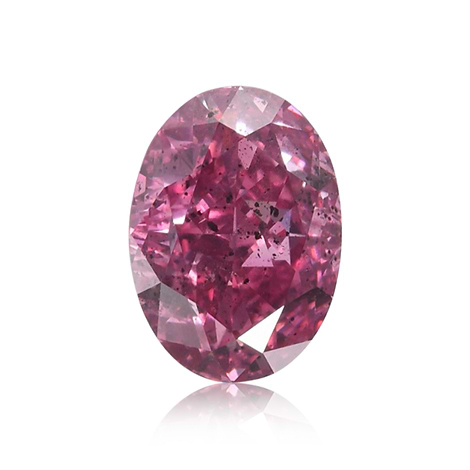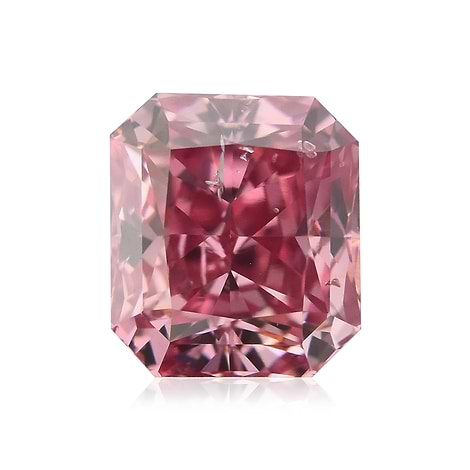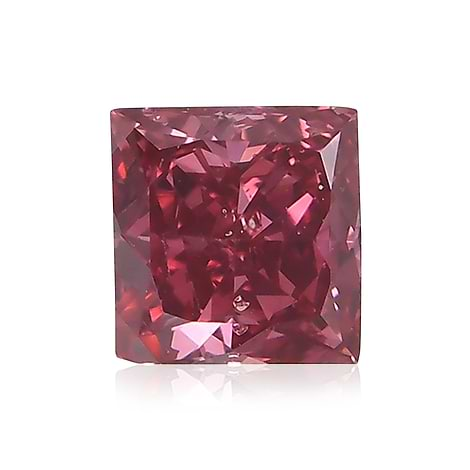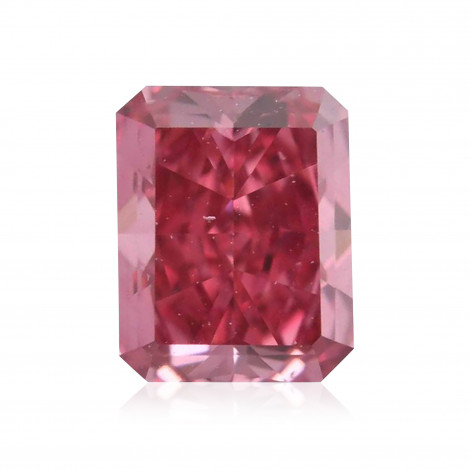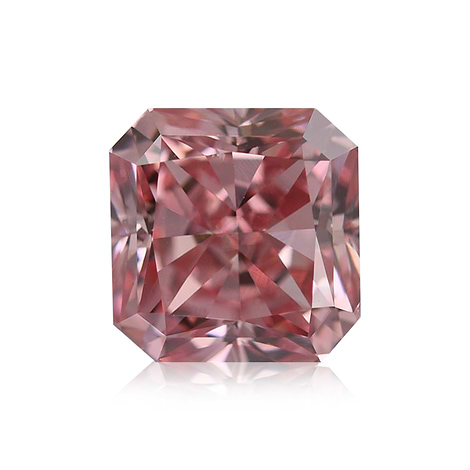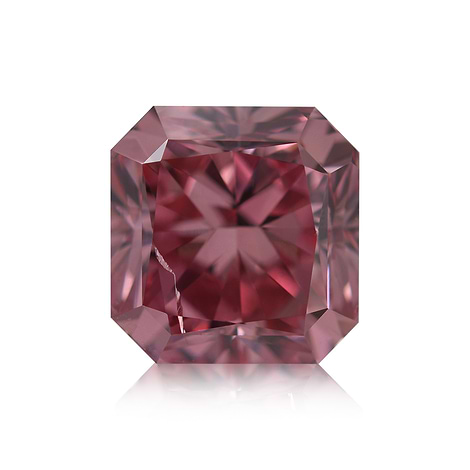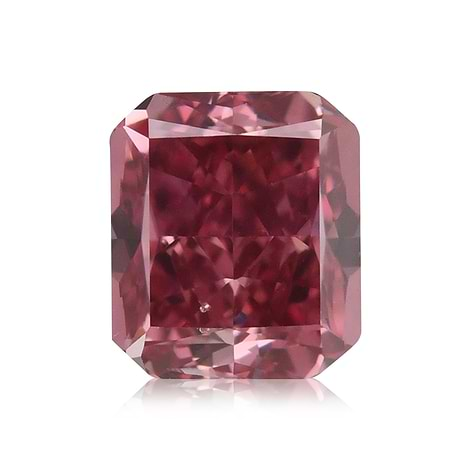THE ARGYLE DIAMOND PHENOMENON
For the last 30 years or so, the Argyle mine has been able to educate and promote its diamonds in very clever ways, a feat that not many mines have ever been able to accomplish. One example is that the mine, owned by Rio Tinto mining corporation, located in Kimberley, Western Australia founded its own certification method. Their certificate now stands as a recognized diamond certification system in its own right, in addition to that of the world renowned GIA (Gemological Institute of America). It has also created its own tender for its top and best quality diamonds that are mined annually. Once a year, it holds its annual Argyle Pink Diamond Tender in which it showcases its best pink, red, and even blue stones from the preceding year.
My subsequent analysis follows my original August 18, 2014 report about this year’s tender. This report encompasses a 25 year period (I have all the tender information since 1990, except for 1993, so this is an analysis covering 24 out
of 30 years of tender stones). During this time, it has offered a total of 1,278 diamonds on tender for a total of 1176.08 carats. This translates to an annual average of 53.25 stones, and an average weight of 49.00 carats per year.
According to official Argyle mine information, it claims it produces 90% of global supply of pink diamonds (it is one of the world top volume diamond producers, but not by value). The Argyle mine claims it offers its top diamonds at the
tender every year. My question is, how does it compare to the other 10% of the global supply, both by value and quality?
According to publicly provided information, since the early days of the Argyle mine, over 750 million carats of diamond rough were mined (until 2013). 80% were brown color, 16% yellow, 2% white, 2% grey, and less than 1% of the diamonds were pink.
From current information provided by Argyle, prices for their tender stones have tripled from the 2000 tender to the 2014 tender. During 2013, they claim that there were the most bids ever for over a million dollars per carat. A 2.09 carat heart, Lot #49 from the 1992 tender has just sold at Christie’s Hong Kong - for a total amount of $5,094,327, or $2,437,477 per carat, a world record
General Impression
I decided to do a more in depth analysis of all of its offerings during the last 25 of 30 years of the tender stones, except for 1993, for which I did not have the information. The analysis took time, as I had to gather all the information and input it into 1 table with various criteria and groups; color, clarity, size. It was no surprise that pink diamonds were the majority of offering, standing at 92.41%. Their blue collection launched in 2009 and other colors, combined, stood at 4.23%, and the rest were red diamonds at 3.36%.
When I looked at the various clarity grades, the majority of stones at 84.98% were in the I and SI clarity group, while 13.07% were of VS clarity. While the remaining 1.95% was of VVS clarity, NONE were in the IF or F clarity, making me question many things, which I will explore later on.
Lastly, in terms of size, 55% or 702 diamonds were larger than 0.75 carats, while the rest were smaller. A good portion (38%, or 485) of the total diamonds were above 1.00 carats. From those above 1.00 carats, only 10 diamonds or 0.78% of the total offered were above 3.00 carats, a true rarity. Only 2001 had a stone larger than 4.00 carats; it was a 4.15 carat Fancy Intense Purplish Pink (1992 had a 5.04 carat stone but it was a grayish green-yellow, so I did not count it as above 4.00 carats). Based on the above information, how is it that some very special pink diamonds have sold in auctions, such as the Graff Pink, Pink Dream and others that were of significant size and superior clarity, and were not from Argyle?
Color Analysis
Red:
In the last 24 years, Argyle has had 16 red diamonds sold at their tender events, a mere 1.25% of all tender stones. These were certified as Fancy Red stones on behalf of GIA; a true rarity. A further 27 stones, or 2.11% (out of 1,278 stones) were described as Fancy Purplish Red; also a rare breed. Having a secondary color such as purplish has never prevented from these stone of earning top dollar, similar to those of Fancy Red ones.
In my analysis, the first Fancy Red diamond from Argyle was offered in 1999. In 2003 and 2004 there were 2 more stones, 1 each year. The real change had started in 2009, where every year since, has had Fancy Red diamonds offered on a yearly basis, peaking at 4 this last tender (2014). In 2013 there were 3, prior to that 1 in 2012, 1 in 2011, and 3 in 2010. Let me remind you that underground mining has started in 2013, but the decision to go underground had started much earlier, in around 2008-2009. On the other hand, Fancy Purplish Red diamonds have been offered more frequently since 1990, averaging a stone every year, and peaking at 4 stones in 2007.
My conclusion is that the polishers have improved their skills and have maximized the color possibility for the tender offering (during 2009-2014 tenders, there were only 3 Fancy purplish Red diamonds offered compared to 13 Fancy reds).

Argyle Fancy Reds vs. Fancy Purplish Reds
Pink:
Obviously, this Color category holds the majority of stones offered, as Argyle is known for offering 90% of global supply of pink diamonds. This color category has offered 1,181 stones, a 92.41% share of the total stones (1,278) offered at tender. The main offerings were Fancy Deep Pink and Fancy Intense Pink, holding 26.84% and 38.34% of the total offerings, respectively. On average 14 stones in the Fancy Deep Pink (FDP) have been offered annually, with a peak of 30 stones in 2000 to a low of 0 in 1990-1994 years and only one in 2014. Between 1995 and 2007 there was a consistent volume offered, and since 2008, there was a decline.
On the other hand, Fancy Intense Pink (FIP) has averaged 20 stones during the same years, a peak of 42 stones in 2011, and a low of 0 in 1990-1991 and a single stone in 1992 and 1994. During the 24 years covered there has been a steady increase in FIP offered at the tender annual event.
Fancy Vivid Pink (FVP) has had a more stable offering. On average 7 stones annually were offered as a Fancy Vivid Pink (FVP); with a peak of 19 in 2010 and a low of 0 in 1990-1994 and a single stone in 1995. But the offerings have been quite stable, and not as fluctuating as the FIP and FDP.
Finally, Fancy Pink (FP) accounted for 172 stones or 13.46% of total offering. The interesting part is that 156 of them, or 90.70% of the FPs have been offered between 1990 and 1994. During that same period of the other 3; FIP, FVP, and FDP were just 2 stones in total. My assessment is that it took until the 1995 for Argyle to gain the experience necessary to reach such colors.
 Depth of Argyle Pink Diamonds at Tenders
Depth of Argyle Pink Diamonds at Tenders
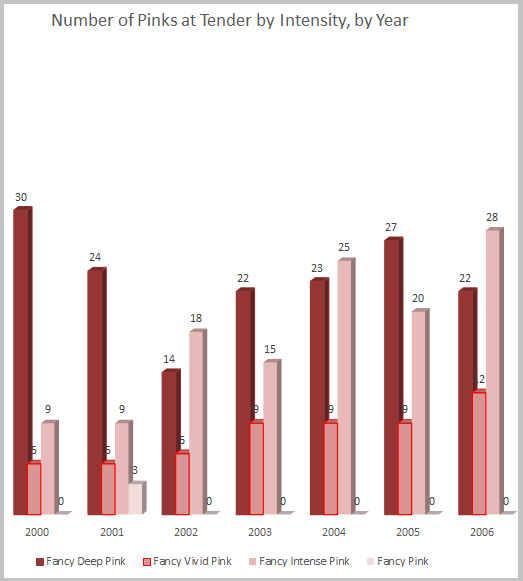 Number
of Pinks at Tender by Intensity, by Year - Click to enlarge, for full graph
Number
of Pinks at Tender by Intensity, by Year - Click to enlarge, for full graph
Other Colors
Other colors, such as Yellow and Blue consisted of only 54 stones or just 4.23% of total offering. 1990-1994 period saw 17 stones offered. During 1995-2011, only 1 to 3 stones were offered, usually in the Grey and Bluish tones while in 2012 there was a 14 stone collection in the tender, only 3 in 2013, and none in 2014.
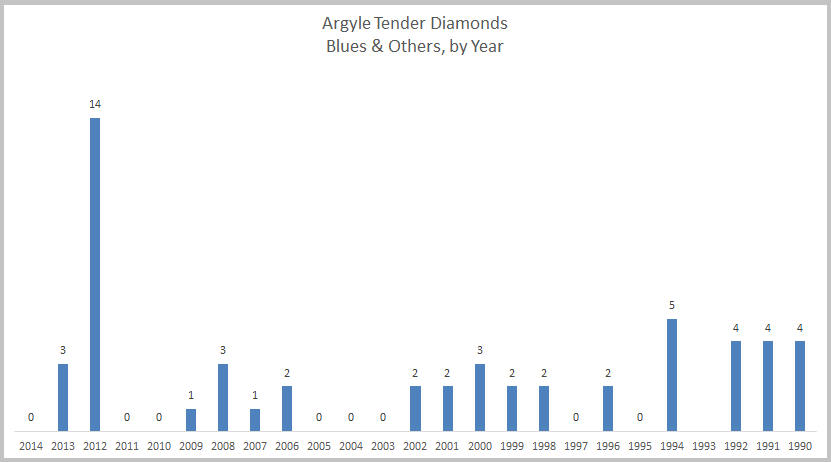
Argyle Tender Diamonds Blues & Others, by Year
Clarity Analysis
It is not surprising that for the clarity of the majority of stones, 84.98% were in the SI and I groups. A further 13.07% were classified as VS, and a mere 1.80% was classified as VVS clarity. None of the tender stones were classified as IF or F clarity.
Nearly half of the stones offered since 1990 (49.77%) were classified as SI stones. On average, 26.50 stones were offered yearly; the high being 37 in 2007 vs. the low of 16 in 1990. Except for 1990 and 1995, on average, the quantity offered ranged in the mid 20’s. For SI, consisting of 35.21% of all offering, the average yearly quantity was 18.75 stones. The range was a high of 30 stones offered in 1998 and a low of 9 offered in 2001.
For the 3rd group, being in the VS clarity class, on average 6.96 stones have been offered yearly. The high was 20 stones offered in 2012, which also happens to be the year where there were the most stones offered, with a low of 1 in 1990. But most years, the quantity ranged between 4-6 stones.
For VVS clarity, being that only 1.80% of stones offered were of this quality, it demonstrates the rarity of such Argyle diamonds.
There were no diamonds offered in the tender that had either an IF or F clarity.
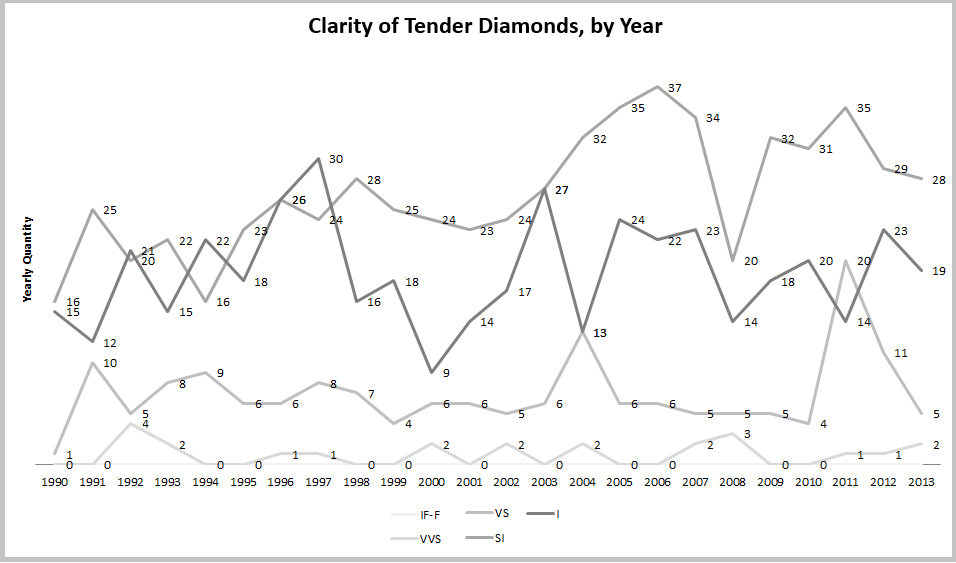
Clarity of Tender Diamonds, by Year

Argyle Tender Diamond Clarity, %
Size Analysis
In order to analyze the sizes of the tender stones, I decided to group them according to the same way colorless diamonds are traditionally grouped (less than 0.33 carats, 0.33cts to 0.49cts, 0.50cts to 0.65cts, 0.66cts to 0.74cts, 0.75cts
to 0.99cts, 1.00ct to 1.49ct, 1.50ct to 1.99ct, 2.00ct to 2.99ct and 3.00cts+). The distribution had a shape of a wave. Low quantity on the small sizes under 0.50cts, then an increase, a low offering on 0.66ct to 0.74ct then an increase
then a low again on the 1.50cts+ sizes. The group that had the most offered was in the 0.50ct to 0.66ct, which was 28.87% of total stones offered. The 2nd group is quite important as this group was in the 1.00ct to 1.50ct group, at 26.45%
of offering. All the other groups were in the single digit percentage.
| 1990 | 1991 | 1992 | 1993 | 1994 | 1995 | 1996 | 1997 | 1998 | 1999 | 2000 | 2001 | 2002 | 2003 | 2004 | 2005 | 2006 | 2007 | 2008 | 2009 | 2010 | 2011 | 2012 | 2013 | 2014 | |
| Size | |||||||||||||||||||||||||
| 3.00ct+ | 0 | 0 | 1 | N/A | 2 | 0 | 2 | 0 | 1 | 0 | 0 | 1 | 0 | 0 | 0 | 1 | 0 | 0 | 1 | 0 | 0 | 0 | 0 | 1 | 0 |
| 2.00ct+ | 6 | 1 | 1 | N/A | 5 | 3 | 2 | 2 | 3 | 5 | 2 | 1 | 4 | 4 | 4 | 3 | 3 | 2 | 2 | 3 | 1 | 2 | 0 | 2 | 2 |
| 1.50ct+ | 3 | 3 | 2 | N/A | 0 | 3 | 4 | 6 | 3 | 5 | 3 | 3 | 3 | 2 | 4 | 2 | 5 | 7 | 2 | 0 | 1 | 3 | 0 | 6 | 4 |
| 1.00ct+ | 10 | 15 | 9 | N/A | 12 | 15 | 7 | 19 | 12 | 12 | 17 | 13 | 10 | 12 | 16 | 21 | 21 | 23 | 25 | 7 | 19 | 14 | 9 | 9 | 11 |
| 0.75ct+ | 2 | 6 | 9 | N/A | 3 | 11 | 11 | 11 | 14 | 6 | 12 | 11 | 7 | 13 | 10 | 10 | 11 | 8 | 10 | 7 | 5 | 8 | 11 | 8 | 13 |
| 0.66ct+ | 3 | 3 | 6 | N/A | 0 | 2 | 3 | 5 | 5 | 6 | 2 | 3 | 1 | 5 | 5 | 6 | 7 | 7 | 9 | 2 | 6 | 3 | 2 | 10 | 6 |
| 0.50ct+ | 6 | 10 | 17 | N/A | 14 | 6 | 13 | 15 | 23 | 17 | 11 | 8 | 14 | 11 | 21 | 16 | 17 | 18 | 14 | 22 | 21 | 19 | 30 | 17 | 9 |
| 0.33ct+ | 4 | 9 | 5 | N/A | 8 | 7 | 5 | 1 | 2 | 0 | 0 | 1 | 4 | 1 | 0 | 1 | 1 | 0 | 1 | 1 | 1 | 5 | 8 | 10 | 7 |
| 0.33ct- | 0 | 0 | 0 | N/A | 3 | 0 | 0 | 0 | 0 | 0 | 0 | 0 | 0 | 0 | 0 | 0 | 0 | 0 | 0 | 0 | 1 | 1 | 10 | 1 | 2 |
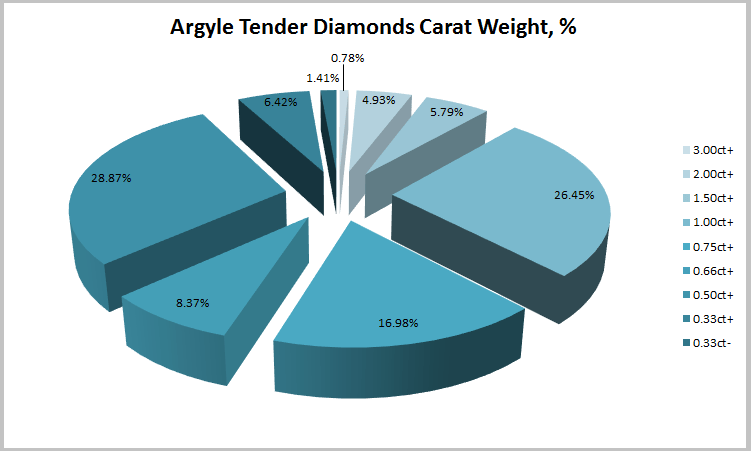
Argyle Tender Diamonds Carat Weight, by % total
What was so different in 2012?
That year was the last year before the mine went underground officially. That year also saw the following unusual offering (according to our analysis):
- The most stones offered, a total of 70 stones (compare to a 34-65 range).
- It
offered 14 stones in the blue shade, the most ever (14 stones).
- It offered the majority of stones under 0.33cts ever (10 out of 18).
- Majority of stones were below 0.75cts in size (71% compared to 45% on average).
- The lowest
average size stone ever (0.61cts compared to 0.92cts on average).
- The lowest quantity of stones over 1.00cts (9 compared to 20.21 on average).
Conclusion
Although the analysis may not be favorable at times to Argyle, the conclusion remains the same as before - the demand for Argyle diamonds increases year after year no matter what. The fact remains that Argyle diamond prices continue to climb to new heights every year. The value has tripled in the last 14 years. For those that know pink diamonds, Argyle diamonds have a special bubble gum color which is a deeper color than pink diamonds from other mines, similar to the difference between a Zimmi yellow to a non Zimmi yellow diamond. Currently Rio Tinto plans to close the Argyle diamond mine by 2020, which means that the supply of pink diamonds will fall by 90%, during a time where the public is becoming more aware of fancy color diamonds and they are appreciating fancy color diamonds, especially Argyle pink Diamonds, and demand will only increase. Based on this information, the secondary market for pink diamonds will grow stronger and prices, based on fundamental economic rules, should increase exponentially.
